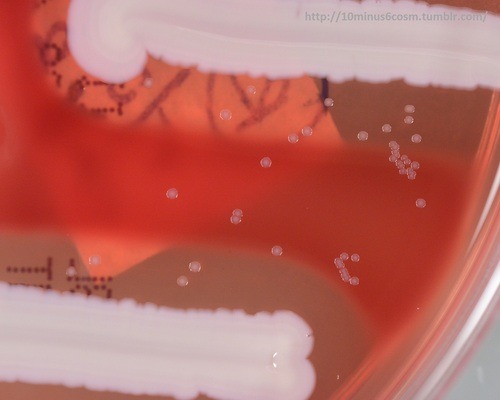Corynebacterium kroppenstedtii
Corynebacteria are Gram positive rods that are found on the skin and mucus membranes. Apart from the well known Corynebacterium diptheriae, they have tended to be dismissed as contaminants in the past.
C. kroppenstedtii was first described in 1998 based on an isolate from the sputum of a patient with pulmonary disease. It lacks mycolic acids-a component of the cell wall in this group of bacteria. Consequently growth on routine media lacking lipids is poor and it exhibits lipophilic behaviour.
Collins MD, Falsen E, Akervall E, Sjöden B, Alvarez A. Corynebacterium kroppenstedtii sp. nov., a novel corynebacterium that does not contain mycolic acids. Int J Syst Bacteriol. 1998 Oct;48 Pt 4:1449-54.
Subsequently, microbiologists in New Zealand noticed an association between this species and human breast infections. In keeping with its lipophilic nature, in histological sections, the bacteria were found within vacuoles which were presumed to contain fat.
Paviour S, Musaad S, Roberts S, Taylor G, Taylor S, Shore K, Lang S, Holland D. Corynebacterium species isolated from patients with mastitis. Clin Infect Dis. 2002 Dec 1;35(11):1434-40.

Very poor growth at just under 24 hours incubation.

After incubating a few days.

Gram stain from culture.
We first identified C. kroppenstedtii in our lab in 2013 (at that time we did not have MALDI-TOF yet and C. kroppenstedtii was not in the API Coryne database. However our resourceful lab technologist TPL had looked up the ASM Manual of Clinical Microbiology and discovered that particular API Coryne biochemical profile was associated with C. kroppenstedtii). In 2013 we had 5 isolates and the following year we had 4. All were associated with breast abscesses except one isolated from a line site. For those patients with breast abscesses, the mean age was 36 years (Range 29-44 years). Breast abscesses due to this organism seem to be quite uncommon with most reports in the literature being single case reports.The New Zealand study above found that those of Maori and Pacific Islander ethnicity were over-represented. In our small series there were 5 Chinese, 2 Indians, and 1 Filipino.
corrodens liked this
10minus6cosm posted this